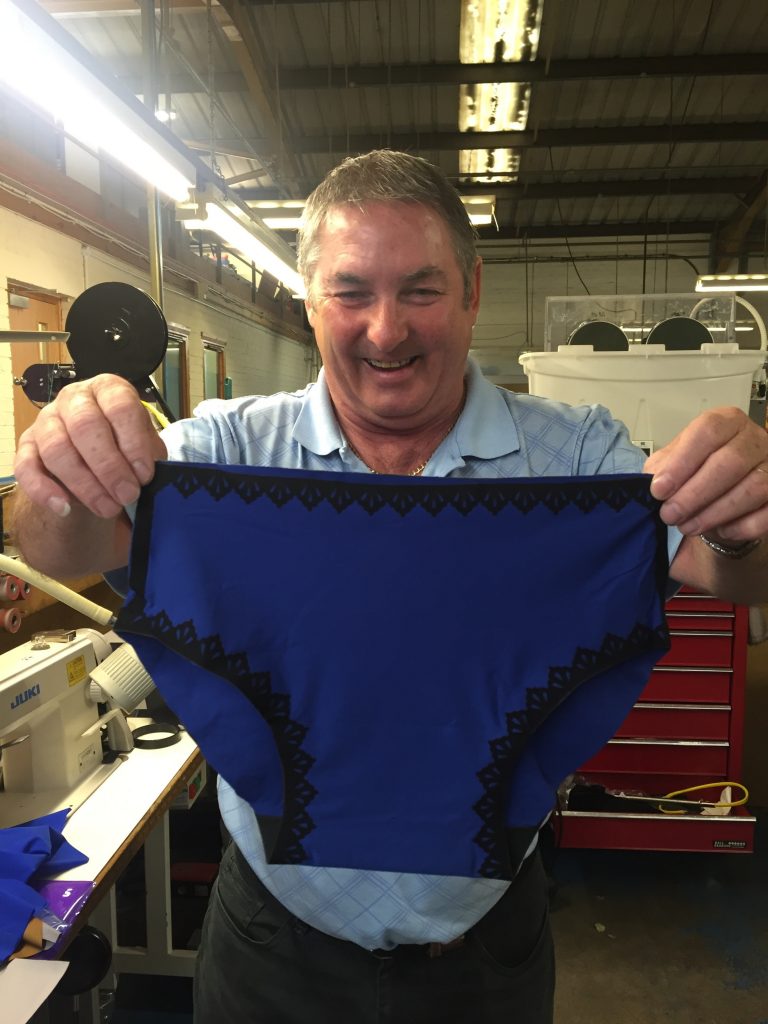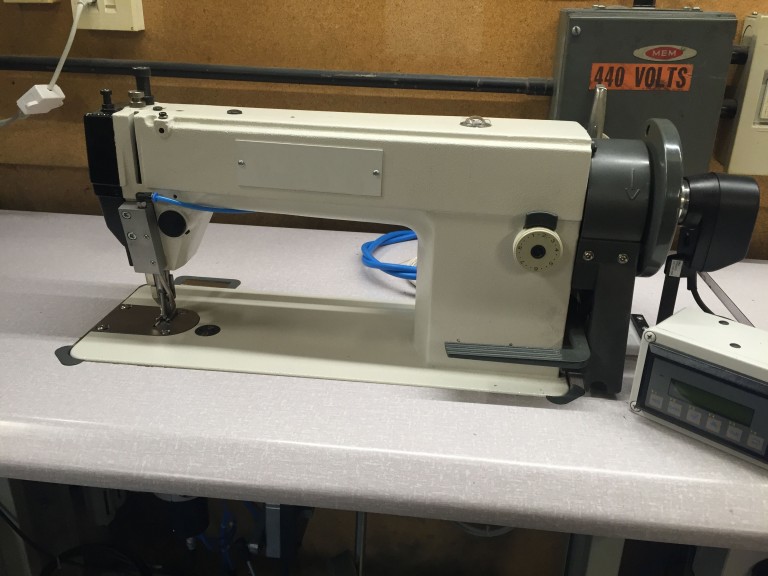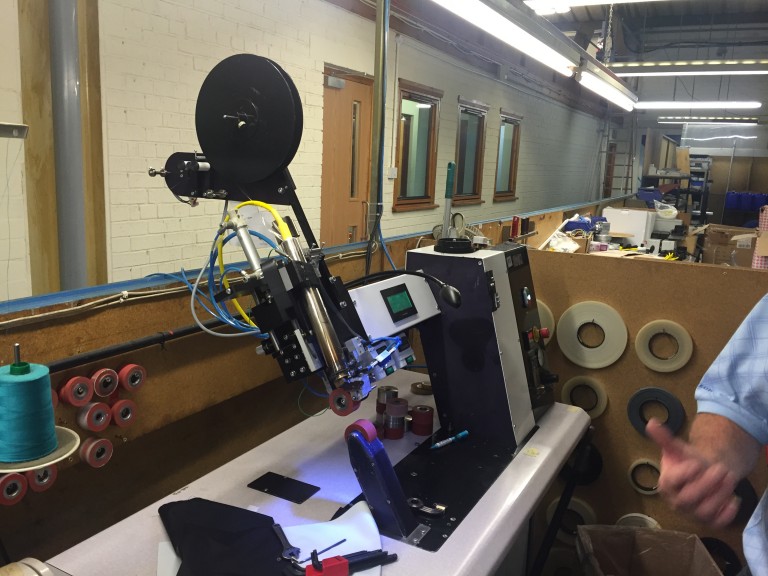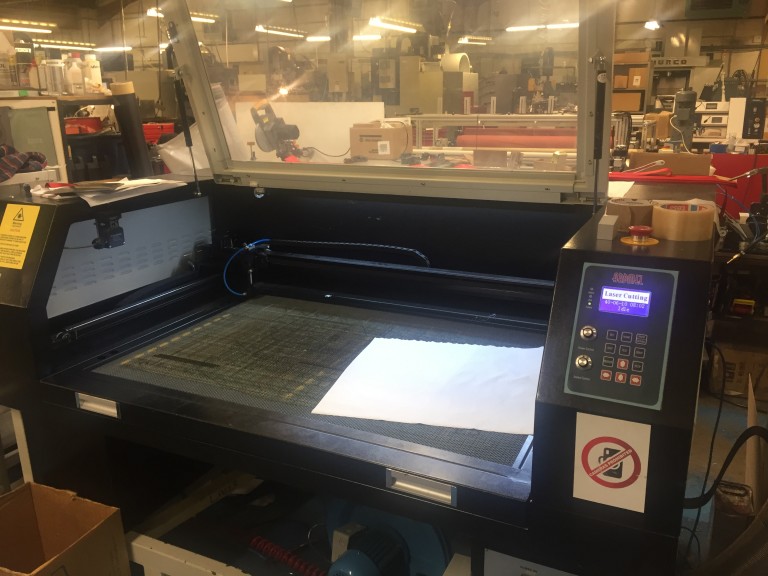
On Monday our Director, Rachael, travelled up North to Scotland to visit a family run factory that we have discovered. The factory specialises in laser cutting, heat bonding and sealing, taping, ultrasonic seams and even inventing and developing the machinery for producing and applying the above specialisms.
Armed with the task of taking as many photo’s as possible, Rachael arrived back from the Highlands with a wealth of knowledge and an accountant blown away by what he saw. Paul is still getting to grips with the world of clothing at Bridge & Stitch! Anyway, the information is so interesting we couldn’t wait to share it with you and we only hope that it will help inspire some of you to consider heat bonding processes within your garments.
So a little info on the factory:
Founded in 1973 as a special purpose automated machine manufacturer, the company has had over 40 years of successful innovation and development, manufacturing machines for companies as diverse as BMW, Ford, Levi’s Jeans and Scandvik. They have been a key player in the tape seam sealing market since the late seventies and continue to dominate this market. The factory leads the way in garment construction technology, allowing big brand names the freedom to be innovative while still combining hi-tech wearability with cutting edge fashion design.
With the recession in the UK, the company unfortunately made the decision to move their production off-shore to Sri Lanka where they still own a factory today. Over the years this factory has gone from strength to strength. They are however now recognising the growing demand for British made products and Bridge & Stitch are thrilled to be one of their first clients for UK manufacture. This is an exciting time for the company and we are so excited to be a part of it.
So how does heat bonding work?
The key to heat bonding is an ultra sonic machine. It looks like a normal sewing machine from a distance however up close you can see that it has been adapted. The ultra sonic machine vibrates creating friction which in-turn creates heat, melting and welding the fabric together. This process alone is not strong enough so the fabric has to be reinforced with tape.

What is tape and how does it work?
Tape is rolled over the ultrasonic seams to strengthen them. Once the tape is applied the seam is stronger than a conventional lock stitch seam. The taping machine can only go over straight lines and moderate curves, it therefore can restrict a design if sharp points or tight curves are required. When ultrasonic machines are used, the tape that can be applied can be as narrow as 10mm. However, when applying a tape to a conventional sewn seam, the taping needs to be wider to ensure that all the perforated holes are covered. Tapes can be as wide as 50mm.

Tape Bonding Machine with rollers
Different rollers are used to apply the tape for different types of fabrics and tapes. As well as tape being used to strengthen seams it can also be used to waterproof seams, applied to the edge of panels to prevent fabric fraying (edge tape), or used to create other finishes such as lapped seams and turned hems. This result is achieved through heat activating adhesive to glue together the fabric layers. It is also possible to apply elastic to the edge of the fabric using heated adhesive.
Bonded hem
Tapes can be made from many different fabrics – custom self fabric, contrast fabric, or off the shelf fabrics. It is also possible to produce tapes with patterns on them.
Below is a picture of Wullie and his ultrasonic knickers! Wullie has worked at the factory for over 13 years and has been at the centre of their innovations and development. In the picture he holds a pair of knickers purely made by ultrasonic machines, heat bonding, and tape.
Wullie and his Ultrasonic Knickers!
How do you create a waterproof heat bonded pocket?
Step 1: Add adhesive to the fabric
Step 1: Add adhesive
Step 2: A jig is made to the shape of the pocket. The fabric is then laser cut out of the jig.
Step 2: A jig is made
Step 3: Heat plate, mini iron, and zip plate. These are all used to heat press the pocket in position.
Step 3: Pocket applied with heat
Step 4: When using laser cutting, the edges could fray so a gasket is added. This is a polyurethane film which is stamped around the edges of the pocket to protect the edges from fraying. If using the ultra sonic machine to cut out, a gasket is not required.
Step 4: Apply a gasket
Wullie is very proud that he can complete the whole process of creating a pocket in under 3 and a half minutes! This is much quicker than the length of time required to create a conventional pocket.
Applying branding to your product through heat bonding.
Most commercial printers now have the capability to apply vinyl heat transfers to garments. The quality of these are improving all the time however it is clear that our factories capabilities go well beyond that of our local printers.
The factory often use a 30/23 polyurethane film with adhesive. They then laser cut out letters and logos etc. to apply a/your brand name or graphic to fabric. This is applied to fabric using a heat press. In order to be applied securely, the adhesive needs to be heated between 350 – 550 degrees. This however does mean that the fabric can be effected, either through shrinkage, puckering, melting, or creating an unwanted sheen on the fabric. Our factory have therefore invented a heat press that has plates that heat at the bottom as well as the top. This means the heat transfer process can be performed more quickly and each heated plate can be cooler, as when pressed together, the desired temperature is still reached, but without effecting the fabric. This gives a much higher quality to the finished heat press.
Heat press with both top and bottom heated plates
Heat bonded branding
Quality and Testing
To ensure that all tapes, ultrasonic seams, and heat bonded seams are to a satisfactory level, they all go through a testing process. The tests completed are as follows:
Machine checking durability of tape / weight test. How strong is it?
Testing the strength of tape
Check pressure of water and seam. Is the seam waterproof? The test can go up to 14 PSI.
Test to check water resistance
Checking flexibility and abrasion resistance of seam and tape. Twisting etc.
Test to check abrasion and twisting resistance
Tear machine – how much does the tape withstand before tearing?
Testing for rips and tears
What other services do they offer?
Laser cutting and engraving. The laser cutter can be used to engrave fabrics. Below are two examples. Ventile fabric – this is a thin fabric and the laser cutter is therefore programmed to merely shave the top of the fabric off leaving an image of the logo behind. Soft shell fabric – this fabric is much thicker so a stronger laser is used to take a larger proportion of the fabric away. It doesn’t cut through the fabric but enough to leave behind the logo. This is a very effective way of applying a logo or image to a garment.
Ventile fabric with laser cutting engraving
Softshell fabric with laser cutting engraving

Laser Cutting Machine
If you would like any further information on laser cutting, ultrasonic seams, and heat bonding, please do not hesitate to get in touch.






